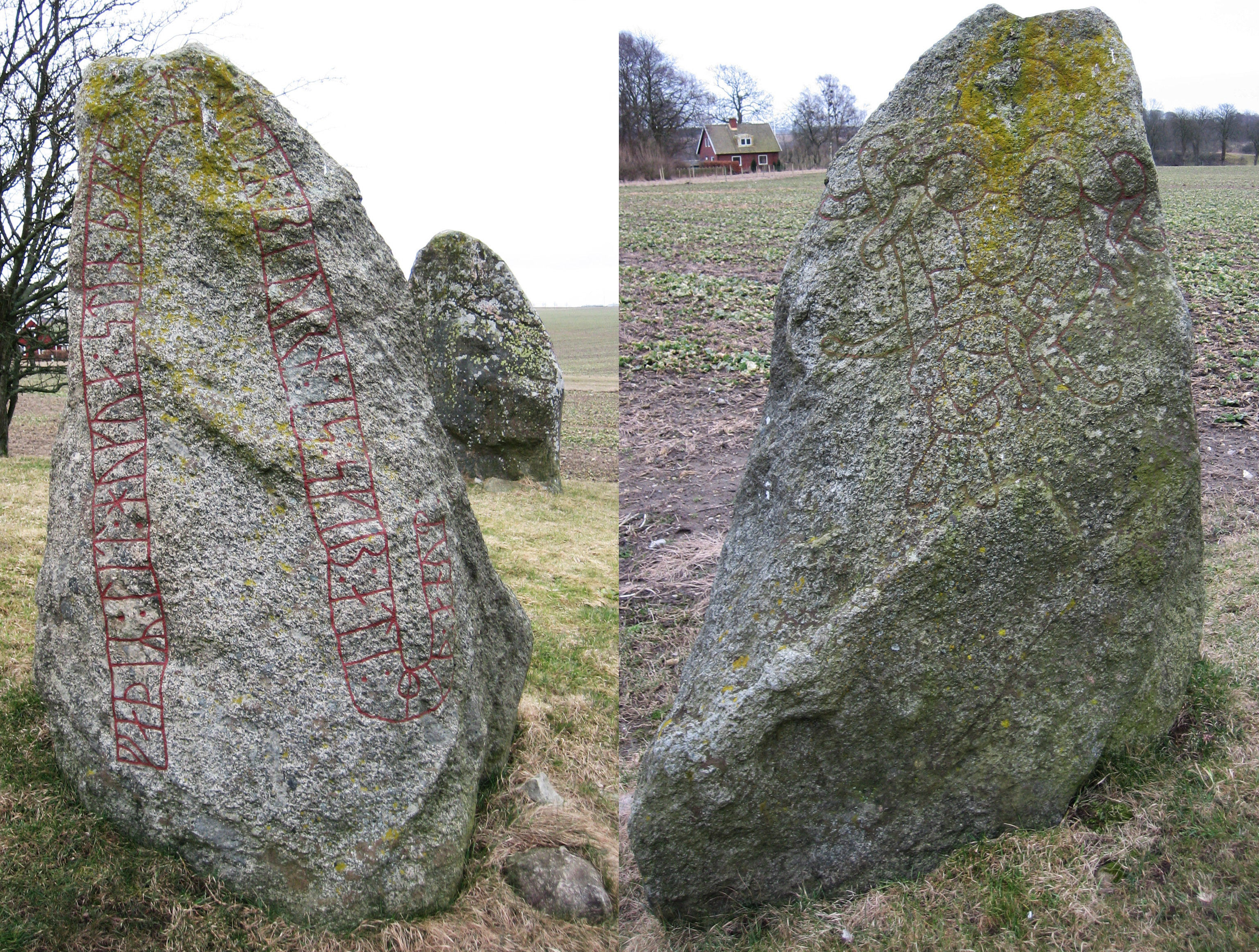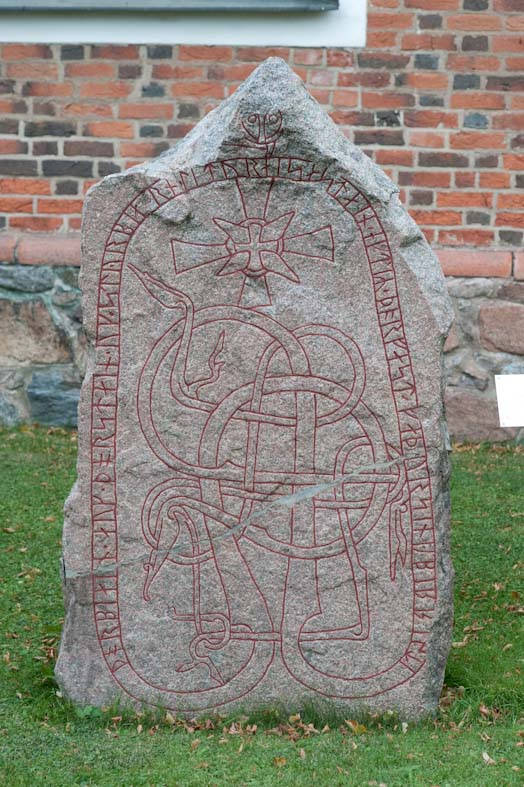|
Södermanland Runic Inscription 367
Södermanland Runic Inscription 367 or Sö 367 is the Rundata catalog designation for a Viking Age memorial runestone located in Släbro, which is one kilometer north of Nyköping, Södermanland County, Sweden, which was in the historic province of Södermanland. The inscription has a facial mask and describes two men as being thegns and the owners of Sleðabrú, which today is modern day Släbro. Description This inscription consists of runic text in the younger futhark in three rows and in an arch around a facial mask. The runestone, which is made of gneiss and is 1.78 meters in height, is classified as being carved in runestone style RAK, which is considered to be the oldest classification. This is the classification for inscriptions that have straight text band ends without any attached serpent or beast heads. The facial mask on this stone is a common motif and is found on several other runestones including DR 62 in Sjelle, DR 66 in Århus, DR 81 in Skern, DR 258 in Bösar ... [...More Info...] [...Related Items...] OR: [Wikipedia] [Google] [Baidu] |
Västra Strö 2 Runestone
The Västra Strö 2 Runestone, listed as DR 335 in the Rundata catalog, is a Viking Age memorial runestone located at the Västra Strö Monument, which is at a church that is about four kilometers northwest of Eslöv, Skåne County, Sweden. Description The Västra Strö Monument consists of five standing stones and two runestones, DR 355 and the Viking runestone DR 334. The two stones have a Danish Rundata catalog number because Scania was part of the historical Denmark during the Viking Age. The monument was surveyed in the 17th century by the Danish antiquarian Ole Worm who documented the inscriptions and reported that it was in good condition. This was not the case during a second survey in 1876 when all stones except one were found to have fallen. The Lund Kulturen restored the monument in 1932. When the stone was raised in 1932, a mask of a man's face was discovered on the other side. This is a common motif and is found on several other runestones including DR 62 in ... [...More Info...] [...Related Items...] OR: [Wikipedia] [Google] [Baidu] |
Scandinavia
Scandinavia; Sámi languages: /. ( ) is a subregion#Europe, subregion in Northern Europe, with strong historical, cultural, and linguistic ties between its constituent peoples. In English usage, ''Scandinavia'' most commonly refers to Denmark, Norway, and Sweden. It can sometimes also refer more narrowly to the Scandinavian Peninsula (which excludes Denmark but includes part of Finland), or more broadly to include all of Finland, Iceland, and the Faroe Islands. The geography of the region is varied, from the Norwegian fjords in the west and Scandinavian mountains covering parts of Norway and Sweden, to the low and flat areas of Denmark in the south, as well as archipelagos and lakes in the east. Most of the population in the region live in the more temperate southern regions, with the northern parts having long, cold, winters. The region became notable during the Viking Age, when Scandinavian peoples participated in large scale raiding, conquest, colonization and trading mostl ... [...More Info...] [...Related Items...] OR: [Wikipedia] [Google] [Baidu] |
Thegn
In Anglo-Saxon England, thegns were aristocratic landowners of the second rank, below the ealdormen who governed large areas of England. The term was also used in early medieval Scandinavia for a class of retainers. In medieval Scotland, there were local officials known as thanes. Etymology The Old English (, "man, attendant, retainer") is cognate with Old High German and Old Norse ("thane, franklin, freeman, man"). The thegn had a military significance, and its usual Latin translation was , meaning soldier, although was often used. ''An Anglo-Saxon Dictionary'' describes a thegn as "one engaged in a king's or a queen's service, whether in the household or in the country". It adds: "the word ... seems gradually to acquire a technical meaning, ... denoting a class, containing several degrees", but what remained consistent throughout was its association with military service. Origins The precursor of thegn was the ''gesith'', the companion of the king or great lord, ... [...More Info...] [...Related Items...] OR: [Wikipedia] [Google] [Baidu] |
Swedish National Heritage Board
The Swedish National Heritage Board ( sv, Riksantikvarieämbetet; RAÄ) is a Swedish government agency responsible for World Heritage Sites and other national heritage monuments and historical environments. It is governed by the Ministry of Culture. The goals of the agency are to encourage the preservation and protection of historic environments and to promote the respect for and knowledge of historic environments. In order to do this, it tries to ensure that Swedish heritage is accessible to all citizens, to spread information about that heritage, and to "empower heritage as a force in the evolution of a democratic, sustainable society". History 17th and 18th century The National Heritage Board was founded in 1630. On the 20May that year, Johannes Bureus who was a prominent rune researcher and King Gustavus Adolphus' private teacher, was appointed the first ''riksantikvarien'' ("National Antiquarian"). Bureus' teachings had made the king interested in ancient monuments an ... [...More Info...] [...Related Items...] OR: [Wikipedia] [Google] [Baidu] |
Fornvännen
''Fornvännen'' ("The Friend of the Distant Past"), ''Journal of Swedish Antiquarian Research'' is a Swedish academic journal in the fields of archaeology and Medieval art. It is published quarterly by the Royal Swedish Academy of Letters, History and Antiquities in Stockholm, Sweden. The journal's contributions are written in the Scandinavian languages, English, or German with summaries in English. The editor-in-chief is Mats Roslund. The Editorial Board practices double blind peer review with external reviewers. ''Fornvännen'' began publication in 1906 when it replaced two earlier journals, ''Svenska Fornminnesföreningens Tidskrift'' and ''Vitterhetsakademiens Månadsblad''. Early contributors included noted archaeologists Oscar Montelius and Hans Hildebrand. Stig Welinder has noted that the journal included articles by women from an early stage, including those of Rosa Norström and Sigrid Leijonhufvud, and characterises this as part of the women's rights movement in Sweden. ... [...More Info...] [...Related Items...] OR: [Wikipedia] [Google] [Baidu] |
Nyköpingsån
Nyköpingsån is a river primarily flowing through Södermanland County in Sweden. The river is named after Nyköping, where it flows into the Baltic Sea. Nyköping is also the largest settlement on the river proper and a large part of the drainage area water is in the corresponding Nyköping Municipality, municipality. Nyköpingsån is one of two rivers to flow into the harbour of Nyköping, the other being Kilaån that winds through the southwestern part of the municipality eastwards from Kolmården. The highest source of the river is the small lake of :sv:Svartsjön (Hallsbergs socken, Närke), Svartsjön in Hallsberg Municipality, Örebro County at above sea level. The innermost and most elevated riverside locality is in Åsbro at when the river passes through the lake of :sv:Tisaren, Tisaren. Although a shorter and lower route, it also leads into the lake of Tisnaren in Östergötland County in the north of Finspång Municipality. That source is further down towards but not q ... [...More Info...] [...Related Items...] OR: [Wikipedia] [Google] [Baidu] |
Jesus
Jesus, likely from he, יֵשׁוּעַ, translit=Yēšūaʿ, label=Hebrew/Aramaic ( AD 30 or 33), also referred to as Jesus Christ or Jesus of Nazareth (among other names and titles), was a first-century Jewish preacher and religious leader; he is the central figure of Christianity, the world's largest religion. Most Christians believe he is the incarnation of God the Son and the awaited Messiah (the Christ) prophesied in the Hebrew Bible. Virtually all modern scholars of antiquity agree that Jesus existed historically. Research into the historical Jesus has yielded some uncertainty on the historical reliability of the Gospels and on how closely the Jesus portrayed in the New Testament reflects the historical Jesus, as the only detailed records of Jesus' life are contained in the Gospels. Jesus was a Galilean Jew who was circumcised, was baptized by John the Baptist, began his own ministry and was often referred to as "rabbi". Jesus debated with fellow Jews on ho ... [...More Info...] [...Related Items...] OR: [Wikipedia] [Google] [Baidu] |
Sjellebro Stone
The Sjellebro Stone is a Viking Age image stone located at Sjellbro, which is about 12 kilometers southeast of Randers, Denmark. The stone is inscribed with a facial mask. Description The Sjellbro Stone is about 1.7 meters in height and features the facial mask of a man. Similar to other image stones, today it is difficult to determine the meaning of the inscription. The facial mask on this granite stone is a common motif and is found on several Scandinavian runestones including DR 62 in Sjelle, DR 66 in Århus, DR 81 in Skern, DR 258 in Bösarp, the now-lost DR 286 in Hunnestad, DR 314 in Lund, DR 335 in Västra Strö, Vg 106 in Lassegården, Sö 86 in Åby ägor, Sö 112 in Kolunda, Sö 167 in Landshammar, Sö 367 in Släbro, Nä 34 in Nasta, U 508 in Gillberga, U 670 in Rölunda, U 678 in Skokloster, U 824 in Holms, U 1034 in Tensta, and U 1150 in Björklinge. Of these mask stones, the Sjellebro Stone is the only one without any runic inscription. The Sjellebro Stone ... [...More Info...] [...Related Items...] OR: [Wikipedia] [Google] [Baidu] |
Uppland Runic Inscription 1034
Uppland Runic Inscription 1034 or U 1034 is the Rundata catalog number for a runic inscription on a runestone located at the Tensta Church, which is three kilometers northwest of Vattholma, Uppsala County, Sweden, and in the historic province of Uppland, that was carved in the late 11th or early 12th century. While the tradition of carving inscriptions into boulders began in the 4th century and lasted into the 12th century, most runestones date from the late Viking Age. Description The runic inscription states that it was ''Øpiʀ risti'' ("Öpir carved"), indicating that it was carved by the runemaster Öpir, who was active in the late 11th or early 12th century. The inscription is carved in runestone style Pr5, also known as the Urnes style. This runestone style is characterized by slim and stylized animals that are interwoven into tight patterns. The animal heads are typically seen in profile with slender almond-shaped eyes and upwardly curled appendages on the noses and the n ... [...More Info...] [...Related Items...] OR: [Wikipedia] [Google] [Baidu] |
Uppland Runic Inscription 824
Uppland Runic Inscription 824 is the Rundata catalog number for a Viking Age memorial runestone located at Holms, which is about eight kilometers east of Örsundsbro, Uppsala County, Sweden, and in the historic province of Uppland. The inscription features a facial mask and a bind rune in the text. Description This inscription consists of runic text carved on a serpent that is intertwined with and encircles other serpents. The inscription is classified as being carved in either runestone style Pr3 or Pr4, both of which are considered to be Urnes style. This runestone style is characterized by slim and stylized animals that are interwoven into tight patterns. The animal heads are typically seen in profile with slender almond-shaped eyes and upwardly curled appendages on the noses and the necks. At the top of the inscription but within the outer serpent is a mask of a man's face. This is a common motif and is found on several other runestones including DR 62 in Sjelle, DR 66 in ... [...More Info...] [...Related Items...] OR: [Wikipedia] [Google] [Baidu] |






